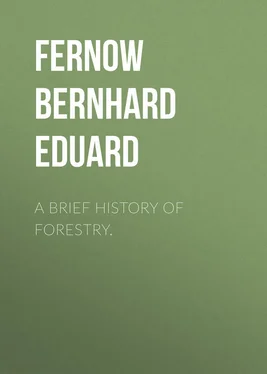Bernhard Fernow - A Brief History of Forestry.
Здесь есть возможность читать онлайн «Bernhard Fernow - A Brief History of Forestry.» — ознакомительный отрывок электронной книги совершенно бесплатно, а после прочтения отрывка купить полную версию. В некоторых случаях можно слушать аудио, скачать через торрент в формате fb2 и присутствует краткое содержание. Жанр: foreign_antique, foreign_prose, на английском языке. Описание произведения, (предисловие) а так же отзывы посетителей доступны на портале библиотеки ЛибКат.
- Название:A Brief History of Forestry.
- Автор:
- Жанр:
- Год:неизвестен
- ISBN:нет данных
- Рейтинг книги:5 / 5. Голосов: 1
-
Избранное:Добавить в избранное
- Отзывы:
-
Ваша оценка:
- 100
- 1
- 2
- 3
- 4
- 5
A Brief History of Forestry.: краткое содержание, описание и аннотация
Предлагаем к чтению аннотацию, описание, краткое содержание или предисловие (зависит от того, что написал сам автор книги «A Brief History of Forestry.»). Если вы не нашли необходимую информацию о книге — напишите в комментариях, мы постараемся отыскать её.
A Brief History of Forestry. — читать онлайн ознакомительный отрывок
Ниже представлен текст книги, разбитый по страницам. Система сохранения места последней прочитанной страницы, позволяет с удобством читать онлайн бесплатно книгу «A Brief History of Forestry.», без необходимости каждый раз заново искать на чём Вы остановились. Поставьте закладку, и сможете в любой момент перейти на страницу, на которой закончили чтение.
Интервал:
Закладка:
Some five or six of the empiricists deserve notice as writers; the first and most noted of them was Doebel ( Heinrich Wilhelm ) whose book, Jägerpraktica (hunters’ practice), published in 1746, remained an authority until modern times for the part referring to the chase. The author was pre-eminently a hunter, who worked in various capacities in Saxony, a self-taught man with very little knowledge of natural history. Being familiar mainly with broadleaf forest he condemned planting and thinning, but described quite well for his time the methods of survey, subdivision, estimating and measuring, and the methods of selection forest and coppice with standards. His ignorance is characterized by his reference to the “sulphurous and nitric elements of the soil” as cause of spontaneous forest fires.
Opinionated and one-sided, like many so-called practical men, he came into polemic controversies with other practitioners, not less opinionated, among them J. G. Beckmann , who worked in another part of Saxony, where, having to deal with coniferous woods, he had gathered different experiences from those of Doebel. Although he was himself poorly educated, especially in natural sciences, he complained of the ignorance of the foresters, and in his book ( Anweisung zu einer pfleglichen Forstwirthschaft , 1759), used for the first time the word Forstwissenschaft (forest science), and insisted upon the necessity of studying nature.
He may be credited with having really advanced forest organization by devising the first good volume division method, and silviculture by advocating the method of clearing followed by sowing.
The first practical forester with a university education was J. J. Büchting , who worked in the Harz mountains. His main interest lay in the direction of survey, division and orderly utilization. He did not, however, make any striking advance, except that he gave equal standing to both planting and sowing.
The two most eminent practitioners of the period, however, active during the middle of the century, were Johann Georg von Langen and his pupil, Hans Dietrich von Zanthier , both of noble family, and better educated than most of their contemporaries, and both engaged in the organization and management of Harz mountain forests, namely, those of the Duke of Brunswick and of the Count of Stolberg-Wernigerode.
The former, without occupying himself directly with literary work, laid down in his expert reports and in his working plans many instructions which form the basis for orderly management and silviculture far ahead of the times. Zanthier, writing considerably (especially Kurzer systematischer Grundriss der praktischen Forstwissenschaft , 1764), is also notable as the founder of the first forestry school (at Wernigerode), 1763.
Another of this class of better educated practitioners, and co-worker with the former two, was von Lassberg , who in 1764-1777 organized the Saxon forests.
An interesting incident in the life of the last three men is their journey to Denmark and Norway, whither they were called to organize the management of the forests connected with the mines.
Another prominent forest manager of the last half of the century, whose literary work is to be found only in various excellent official instructions, among which is one for the teaching of foresters, was the head of the Hessian forest service, a nobleman, v. Berlepsch .
Of the cameralists who helped to make forestry literature, six or seven deserve mention. These, men of education and polyhistors, were either at the head of affairs, or else professors at universities, where they included forestry as one of the branches of political economy.
The credit of the first really systematic presentation of forestry principles and rules, as developed at the time, belongs to Wilhelm Gottfried von Moser , a pupil of von Langen, who served in various principalities, and finally with the Prince of Taxis. In his Principles of Forest Economy , published in 1757, which for the first time brought out the economic importance of the subject, he discusses in two volumes divided into nine chapters the different branches of forestry.
A mining engineer, J. A. Cramer , came next with a very notable book, “ Anleitung zum Forstwesen ” (1766), which, although not as comprehensive as Moser’s, treats the subject of silviculture very well.
Equal in arrogance and opinionated self-satisfaction to any of the empiricists with whom he frequently crossed swords, was the Brunswick councillor, von Brocke , who, as an amateur, practising forestry on his own estate, developed the characteristic trait of the empiricists, namely, a profound belief in his own infallibility. He produced, besides many polemic writings, in which he charged the whole class of foresters with ignorance, laziness and dishonesty, a magnum opus in four volumes, entitled “ True bases of the physical and experimental general science of forestry ,” which is an olla podrida of small value.
Less original, but more fair and well informed, a typical representative of the cameralists, was J. F. Stahl , finally head of the forest administration of Württemberg, and at the same time lecturer on mathematics, natural history and forestry at the forest school of Solitude (Stuttgart). Although an amateur in the field of forestry, he was a good teacher and left many valuable and wise prescriptions evolved during his administration.
He compiled in four volumes a dictionary of forest, fish and game practice ( Onomatologia forestalis-piscatoria-venatoria , 1772-1781) and founded the first forestry journal.
Since 1770, forestry courses had been given for the cameralists at most of the German universities, and many of the professors prepared textbooks for the purpose. At least three of these professors deserve mention, Beckman, Jung and Trunk.
The first, J. Beckman , professor of political economy at Göttingen, one of the most noted cameralists, was author of a work in forty-five volumes on the Principles of German Agriculture (1769), in which he devotes sixty-one pages to forestry, giving a complete system of forestry, with extracts from all known forestry writings.
J. H. Jung , who gave a special course on forestry at the Kameralschule of Lautern, published a textbook in 1781 in which forest botany was well treated.
J. J. Trunk , who was Oberforstmeister in Austria, as well as professor at Freiburg, was the most prominent of the three, and wrote a comprehensive work full of practical sense ( Neues vollständiges Forstlehrbuch oder systematische Grundsätze des Forstrechtes, der Forstpolizei und Forstökonomie, nebst Anhang von ausländischen Holzarten, von Torf und Steinkohlen , 1789).
While at first the ephemeral writings, especially the polemic ones of the empiricists, found room in literary and cameralistic magazines, the need of a professional journal first found expression in 1763, in Stahl’s Allgemeines ökonomisches Forstmagazin , which ran into twelve volumes, and contains many articles important to the history of forestry, and is especially rich in its references to foreign literature.
Two continuations of the magazine under different editorships were of less value. But von Moser’s Forstarchiv , running from 1788 to 1807 with its thirty volumes, is an authority and a historical source of the first rank.
A very characteristic literature of the last half of the 18th century consisted in forest calendars in which advice as to monthly and seasonal procedures in the forest were given, Beckman and Zanthier being among the authors.
III. Development in the Nineteenth Century
Интервал:
Закладка:
Похожие книги на «A Brief History of Forestry.»
Представляем Вашему вниманию похожие книги на «A Brief History of Forestry.» списком для выбора. Мы отобрали схожую по названию и смыслу литературу в надежде предоставить читателям больше вариантов отыскать новые, интересные, ещё непрочитанные произведения.
Обсуждение, отзывы о книге «A Brief History of Forestry.» и просто собственные мнения читателей. Оставьте ваши комментарии, напишите, что Вы думаете о произведении, его смысле или главных героях. Укажите что конкретно понравилось, а что нет, и почему Вы так считаете.












